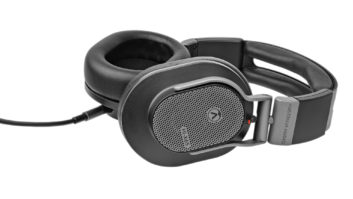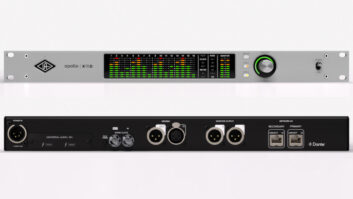
The C600 includes a software mixer for routing inputs and software returns to outputs and headphones.
With the release of Pro Tools MP this year, users have been buzzing about the possibility of an upgrade to M-Audio’s hardware. The company’s devices were preferred by many over their LE rivals because of its thorough feature sets, abundance of I/O and reasonable prices. The answer has come in the form of the new M-Audio Fast Track C400 and Fast Track C600 (reviewed here) USB interfaces.
ON THE SURFACE
The Fast Track series’ overall cosmetic design has gotten a complete overhaul. No longer do we see the stackable unit with a narrow front control panel. The new design takes a note from desktop interfaces like the Apogee Duet, with a large volume control and a generous spread between knobs and buttons across the large top surface. Ergonomically, this is a refreshing alternative. Other welcome additions, which I haven’t seen from the Fast Track line before, are the 8-segment LED input meters, innovative monitoring section and transport controls. All of these new bells and whistles are built upon a solid foundation mirroring the impressive feature set of the Fast Track Ultra.

The top of the unit has a generous spread between knobs and buttons.
The Ultra offered plenty of input and output options, with quality mic pre’s, dual independent headphone mixes and MIDI I/O, as does the C600. One of the most impressive Ultra features, however, was the software mixer for routing inputs and software returns to outputs and headphone mixes. The ability to mix zero-latency inputs with playback tracks and effects powered by DSP from the hardware was professionally executed. The C600 improves upon this with stylish new graphics and even more options.
INPUT SELECTIONS
The C600 can accept signal from four analog inputs simultaneously. On the back panel of the unit, four XLR/¼-inch TRS combo jacks can accept mic or line-level signals. Alternatively, the first two inputs can be fed by front panel instrument jacks. Comparing the C600’s preamps to the Fast Track Ultra’s, I found a strikingly similar character. Recording vocals, I noticed the same tight low and low-mid frequency range with plenty of substance, without being over-emphasized. The top end is smooth and balanced, without an abundance of additional harmonics seeming to be added. Most of all, the upper-midrange from the preamp/converter pairing has an impressive amount of detail and clarity for a product in this class. Several M-Audio products—including the ProFire Series, the Fast Track Ultra and Ultra 8R—include the “Octane circuit” in M-Audio’s Octane preamp/converter. These pre’s have distinctly superior gain, fidelity and flavor to those found in the Fast Track Pro. I would not be surprised if that same circuit was the basis of the C600’s preamps.
By contrast, plugging an electric guitar into the instrument input on the front panel was slightly disappointing. This was an area that I felt could have used improvement on the original Fast Tracks, and after using the HD Omni I/O, I learned what a well-executed instrument input could really sound like. Granted, the Omni and the Eleven Rack, which apparently was the basis of the Omni’s instrument input circuit, are in a higher price class than the C600. That said, with the Avid brand name shared by M-Audio, I had hoped that a lower-cost yet comparable design might have trickled down to the C600. The Omni felt like plugging into an actual guitar amp. I plugged in, never really had to adjust a gain control on the device, and a hot, meaty signal lit up an Amplitube Fender Twin. With the C600, I had to keep backing off level, padding the input and scaling back gain further and further to avoid clipping. By this point, the signal felt thin and compromised, and my performance still felt inhibited by my fear of overdriving the A/D converter. A DI through the C600’s mic pre provided a superior experience.

The C600 I/O includes MIDI, USB, S/PDIF line out (six) and mic/line in (four).
MANAGING OUTPUTS
The C600’s output strategy was clearly a point where M-Audio focused on customer feedback, executing a fantastic solution. The unit offers six analog outputs using TRS ¼-inch analog connections. The unit also offers two headphone jacks on the front panel, each having their own level control on the top. What is fed to each of these analog connections is controlled by the software mixer in the C600 Preference pane in the Mac OS System Preferences. The layout of the GUI found here will be a comfortable transition for Fast Track Ultra users. It can be a bit confusing at first, but only because it is so packed with features.
Any piece of software sending signal to the C600 recognizes it as having eight outputs, including the six analog and the S/PDIF. Routing signal to output 1 from, say, Pro Tools will bring that signal into the software mixer’s “Software Return 1.” This signal can then be routed to any of the device’s physical outputs. By default, all eight software returns are routed to the corresponding physical connections, but you can easily modify this. In a similar way, the four analog and two S/PDIF inputs arrive into the software mixer previous to the A/D and D/A converters so that latency-free signal can be routed to any or all of the physical outputs. The first headphone mix will mirror the mix being fed to physical outputs 1 and 2, and the second headphone output will receive the output 3/4 mix. A new feature in the C600’s software mixer is the ability to copy the output 1/2 mix over to output 3/4 to create identical mixes for both cues or output paths. Likewise, any output pair’s mix can be copied to any other output pair’s routing page.
Each of the inputs and software returns feature an aux send that can feed signal to the onboard effects processor. By using the unit’s DSP to provide reverb or delay effects, the responsiveness of the processing is fast enough to be provided without latency. Eight different styles of reverb and delay offer simple controls, but are capable of producing sounds that allow a singer or guitarist to feel comfortable hearing his/her performance playing through the zero-latency inputs without being awkwardly dry.
The way that this software mixer integrates with the hardware monitor section is where the C600 really raises the bar. The large volume control on the unit’s top panel is accompanied by three buttons, corresponding to the three analog output pairs. The idea is that, for one, during a mixing situation each pair of outputs is connected to a different set of monitors, each output pair is being fed an identical mix and the volume control adjusts the output level as the mix is evaluated on each monitor pair. You can switch between monitor pairs by turning on and off the corresponding buttons. Alternatively, during tracking you might have your main mix feed outputs 5/6 to your monitors, allocating that mix to the main volume control and freeing up the other stereo pairs for independent headphone mixes. Most exciting, in my opinion, is that 5.1 audio from a DAW can be routed to the six analog outputs; all three pairs can be selected to feed the main level control simultaneously, and the large volume control can adjust the level of the entire surround mix.
With all of these flexible routing options within the software mixer, a great variety of professional workflows can be managed in very comfortable ways. Comparing to the hardware setup of the HD Omni I/O, I would say that the C600 software routing takes a slight edge in terms of overall look, ease of use and features. The copy/paste feature and DSP effects alone push it over the top. The software control panel for the C600 also handles the transport feature. The five transport buttons are a tad small and stiff for my taste, but I could see why some would find them useful. They are recognized by the Mac OS as a USB keyboard. With that in mind, you can program each of the buttons to play a keyboard shortcut recognized by the desired application as a specific command. Setting the Play button to perform the “spacebar” command makes the button useful in pressing Play in a good number of applications. Fast-Forward and Rewind, on the other hand, will find themselves very DAW-specific once programmed. An additional Multi button can be programmed to perform any shortcut, or even an eight-step series of commands.

ALL GOOD?
Clearly, there are a lot of positive things happening with the Fast Track C600. Great design, good amount of I/O, pleasing sonic quality and a useful new monitoring section are all among them. I do have some minor complaints. I have always liked the Fast Track Ultra, and was excited to see this new product that adds to all of my favorite Ultra features. The C600 does not offer hardware inserts, which were useful on the Ultra, and the C600 has two fewer line inputs. Otherwise, the C600 only improves upon its predecessor.
One thing I had hoped to see resolved on the C600 was the issue of hot-swappability. Both units are made to perform in a way that they can operate using exclusively USB power but only offering two ins and reduced outputs. To achieve full I/O, an additional wall wart power supply must be connected. Usually for the unit to be recognized in this mode, a reboot is required. Sometimes the unit will be found without rebooting, but it just isn’t consistent. One or two times, the C600 exhibited some sort of clocking issue where the sound crackled until power was recycled, leading to a necessary reboot, all during a session. It would be really annoying if that happened consistently.
WORTH THE WAIT?
A new fleet of M-Audio USB interfaces has been long anticipated, but it seems that the company has taken its time and gotten it right. The slick new layout is much more appropriate for the kind of desktop use where it will most likely be popular. The powerful software mixer gets even better in this new generation. The sonic quality doesn’t seem like a radical leap forward, but really didn’t need a major revamp. It’s worth noting that even the C400 is reportedly receiving the same type of quality mic pre’s and software control found on the C600, so that’ll be a major step forward from the Fast Track Pro. Playing the features-per-price game is always a balance of tradeoffs, and it seems like M-Audio is at it again, finding the perfect recipe of bang for the buck.
Brandon T. Hickey is a freelance engineer and audio educator.

Click on the Product Summary box above to view the FastTrack 600 product page.







